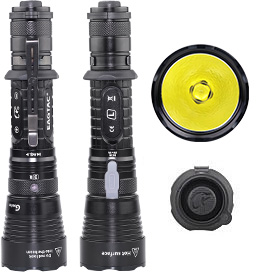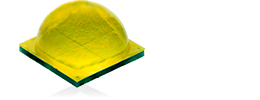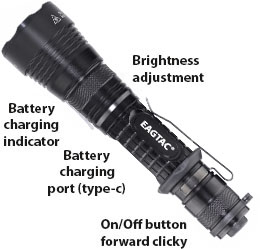Dimensions
- Head Dia.
- 1.6 inches (39.5 mm)
- Body Dia.
- 1 inches (25.4 mm)
- Length
- 6.2 inches (157 mm)1
- Weight
- 6.6 ounces (189 grams)1

Battery Type
- 1x186502
- Compatible battery (diameter/length)
- 18650: (18-18.8mm/65-68.8mm)
- Battery and protection board must supports 10A discharge or higher
- Do not use CR123A in this flashlight
- Read precaution with li-ion batteries.
Operating voltage
- 2.7V - 4.2V
What's included
- G3L flashlight
- Crenulated stainless steel black bezel
- EAGTAC 18650 3400mAh li-ion battery (built-in 10A protection pcb at anode)
- Add-on diffuser filter with flip-cover feature
- Heavy duty nylon holster
- Type-C (bi-direction insert) USB charging cable (3.3feet/1meter) w/ AWG24 copper wire
- 10A high current forward clicky tailcap
- Removeable harden stainless steel deep pocket clip with titanium alloy dark vacuum coated finish
- Spare o-rings
- User Manual
- Mil-Spec Para-cord Lanyard w/ quick attachment clip
Carrying method
- Para-cord lanyard with quick attachment clip
- Heavy duty nylon holster
Waterproof
- IPX-8 standard
Replaceable items
- Lens
Reflector
- Smooth aluminum reflector
Material
- HAIII hard anodization aerospace aluminum
LED
- CREE XHP70.2 P2 Cool White LED
- CREE XHP70.2 N4 Neutral White LED

Beam Profile
CREE XHP70.2 P2 Cool White LED- Center lux: 15,200 lux
- Center spot angle: 12.6°
- Spill light angle: 58°
- Beam distance: 269 yards / 247 meters
- Center lux: 13100 lux
- Center spot angle: 13.7°
- Spill light angle: 62°
- Beam distance: 250 yards / 229 meters
Lens
- Waterwhite glass lens w/ harden treatment
- Anti-reflective (AR) coating on both side (96% transparency)
LED circuit
- W2500 Pro
- Synchronous boost converter with ultra low resistance power mosfet which offers up to 96% efficiency and high voltage LED output
- Uses seven large capacity MLCC for input and output decouple
- Four layers FR-4 PCB for better heat transfer, lower EMC, and higher output power
- Uses molded power inductor for higher saturation current and less electromagnetic interference
- Current regulated output (non-PWM) for all brightness levels without flicking
- Low voltage output step-down at 3V (lowers MAX output to second highest level to extend remaining runtime)
- Low voltage output step-down at 2.7V (lowers any output to lowest level to extend remaining runtime)
- Built-in shut down voltage at 2.5V (if voltage reaches 2.5V at the lowest level, the flashlight will turn off)
- Active thermal management feature (adjustment range 70%-100%)5
- Zero standby current
- Battery level report
Charging circuit
- L1000 Type-C
- 5V USB input (requires 1A or higher)
- 1000mA MAX charging current
- Uses the latest standard type-c usb charging plug, supports bi-direction insert
- Constant current / Constant voltage charging algorithm
- Small current charging for low voltage battery (less than 3.0V)
- Extends battery cycle life by charging battery that reads 4.05V or lower
- Precise voltage detection design +/- 1%
- No trickle charge
- Smart charging level report system
Battery level report
- A blue LED indicator under the main switch reports the estimated battery remaining capacity
- Flash once: lower than 10%
- Flash twice: 30%-50%
- Flash 3x times: 50%-70%
- Flash 4x times: higher than 70%
Charging level report (charging)
- A blue LED indicator under the main switch reports current charging level
- Flash once: lower than 50%
- Flash twice: 50%-75%
- Flash 3 times: >75%
- Constant on: 100% (done)
Output and Runtime
- Three brightness levels
- Programmable Medium and Low levels
- Led lumen:
- Max: 3200-20005
- Medium: 1350-950-455-Strobe
- Low: 115-60-18-Strobe
- ANSI FL-1 lumen:
- Max: 2600-16505
- Medium: 1125-790-385-Strobe
- Low: 98-50-15-Strobe
- Runtime6:
- Max: 0.6-1 hrs
- Medium: 1.5-2.4-4.9 hrs
- Low: 22-42-135 hrs
- Four hidden auxiliary outputs
- Disorienting strobe/Flash/S.O.S./Beacon
- User programmable tailcap strobe
Operations
Basic operations:- Tactical forward clicky switch
- Basic operation
- Turn on the light by pressing the tailcap button until it clicks.
- Twist the head to select between three output levels.
- Pre-selected output level before turning on the light.
- Cycle through auxiliary modes: tight the head (1st level), and loose the head (3rd level) and then tight the head within one second to enter auxiliary setting. Repeat to cycle through all settings. Turn off the light or loose the head to quit.
- Advanced operation
- Choose one of the four levels as the default medium output: Switch to medium output and turn the flashlight on and off for 20 times to cycle through the next output setting.
- Choose one of the four levels as the default low output: Switch to low output and turn the flashlight on and off for 20 times to cycle through the next output setting.
- Tail strobe feature (off by default): With this enabled, you can access strobe output at the tailcap switch button . To toogle this function, switch to 1st level and turn the flashlight on and off 20 times. With the tailcap strobe setting enabled, a double press of the switch button will activate the strobe output.
- Remove the waterproof cover and insert the included type-c charging cable to charge the battery. User must turn on the flashlight switch at the tailcap to charge.
- Blue side LED indicates the battery is being charged. It reports charging percentage by blinking.
- Maximum charging time for a depleted battery: 2.5-3 hrs (2600mAH 18650 li-ion), 3.5-4 hrs (3400mAh 18650 li-ion)
- LED direct soldering on copper for maximum heatsink ability
- User replaceable glass lens
- Battery reverse polarity protection
- Ultra low internal resistance phosphor bronze springs (silver coated)
- Spring loaded positive and negative terminal
- One piece head design for maximum heat transfer
- Tailcap battery stabilizer design to prevent battery movement inside the battery tube
- Ten years performance guaranteed warranty
- Read flashlight regular maintenance
Controls

Other features
Warranty
Battery Safety Precaution
Ensure the protection circuit on the 18650 battery to have current trip of 10A or higher (EAGTAC 18650 3400mAh with protection PCB built-in at anode both have 10A trip current). Always use proven EAGTAC batteries for best performance and reliability. Safe chemistry IMR 18650 li-ion are also supported, however use it with precaution as they are unprotected.All EAGTAC flashlights are designed to use button-top battery (battery with protruding positive terminal). For rechargeable li-ion battery, use only EAGTAC li-ion battery, or other protected li-ion battery with compatible length and diameter. Before using the battery, check and ensure the battery outer wrapping (the isolating plastic film that wraps around the metal housing of the battery) is complete. Broken battery wrapping may lead to short circuit and damage to the flashlight.
Lithium and Li-ion battery can explode or cause burns if disassembled, shorted, or exposed to high temperature. Do not mix new and used batteries. Do not mix batteries with different brand, capacity, voltage, or install batteries backwards.
NiMH rechargeable battery may release gas during discharge. If you experience an inflated switch boot or find high pressure being built inside the flashlight, switch off the flashlight immediately. Slowly loosen the tail-cap to reduce the internal pressure and replace all batteries. Back to top
Flashlight Maintenance
Periodically clean the threads and o-rings with a lint free cloth and apply a thin coating of EAGTAC synthetic grease to the o-rings and threads. After prolonged exposure to moisture, the head and batteries should be removed, inspected, and dried. Do not touch or attempt to clean the reflector, as it will scratch the reflective coating permanently. Back to top- This weight measurement includes battery
- All batteries must have protruding top button. Protected li-ion battery with 2.5V low voltage cut-off setting is recommended.
- Beam output diameter taken at one meter
- ANSI FL-1 Lumens is a measurement of light output standardized by American National Standards Institute for use with flashlights. This ANSI Lumen measurement is the total overall light output being emitted from the flashlight measured in a calibrated integrated sphere. This measurement is generally more accurate as it takes into consideration the loss from reflector/lens/bezel.
- After 30 seconds at maximum output level (100%), the active thermal management feature will be activated and continuously adjusts the maximum output level according to the flashlight internal tempearture. The adjustment output range is between 60% to 100%. This feature maintains the flashlight surface temperature to be about 140°F (60 °C) (higher surrounding temperaturemay result in higher flashlight temperature). It's normal for high power flashlight to run hot at MAX level. Reduce the output if the user finds the flashlight too warm to hold.
- Runtime is measured using one EAGTAC 3400mAh high discharge (10A) 18650 li-ion batteries. MAX level runtime includes out-of-current regulation time period when battery is almost depleted. With active thermal management feature, runtime in cooler environment will have shorter runtime (higher MAX output) and long runtime in hotter environment (lower MAX output). Using EAGTAC 3500mAh with Sanyo GA cell yields approximately 5% to 10% longer runtime depending on level output.
- To charge a deeply discharged protected li-ion battery, the flashlight internal charging circuit will use small current to charge the battery. Usually it takes at least a few minutes for the charging circuit to bring the deeply discharged battery voltage to higher than 3.0V (which is the no-load voltage required to disable the over-charge lock-out on the battery protection circuit). If the protected li-ion battery fails to activate, contact our customer services about your situation and we may find other ways to activate it.
- Details and feature maybe subject to change without notice.